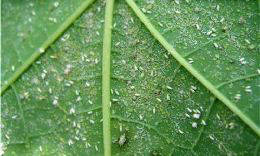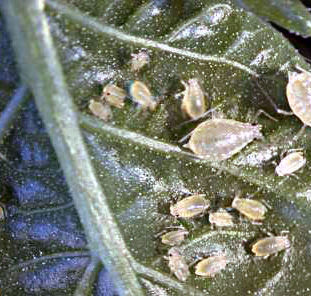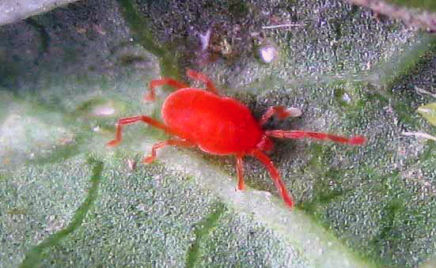
Mealy Bugs
Damage symptoms
• Initially the affected portion will be cholotic, later changed to brown and dry away.
• These bug excrete honey dew and as a result infested portion becomes shiny and moist and to this, secondary infection by sooty fungus, Capnodium occurs results in black covering the affected parts.
• Papaya mealy bug is polyphagous pest. Symtopms can be observed on ground parts of leaves, stem and fruits as clusters of cotton like masses
Management
These three natural enemies Acerophagus papaya, Pseudleptomastix mexicana and Anagyrus loecki were imported to India July 15th 2010 from Puerto Rico under USDA -APHIS facilities (United States Department of Agriculture. Animal and Plant Health Inspection Service), mass multiplied at various laboratories and released in fields.

White fly
Symptoms
• Both the adults and nymphs suck the plant sap and reduce the vigor of the plant. In severe infestations, the leaves turn yellow and drop off. When the populations are high they secrete large quantities of honeydew, which favors the growth of sooty mould on leaf surfaces and reduces the photosynthetic efficiency of the plants.
Management : The natural enemies of whitefly are :
• Parasitoids: Encarsia formosa, Eretmocerus spp., Chrysocharis pentheus
• Predators: Dicyphus hesperus , Lacewing, Ladybird beetle, Big-eyed bugs (mirid bug) (Geocorissp).

Aphids
Symptoms
• Infesting tender shoots and under surface of the leaves.
• Curling and crinkling of leaves
• Stunted growth
• Development of black sooty mould due to the excretion of honeydew
Management : The natural enemies of aphids are
• Parasitoids: Aphidius colemani, Aphelinus sp.,
• Predators: Fire ant, Robber flies, Big-eyed bug (Geocoris sp), Earwig, Ground beetle, Cecidomyiid fly, Dragon fly, Praying mantis, Lacewing, Ladybird beetle, Spider etc.

Red spider mites
Symptoms:
• Spider mites usually extract the cell contents from the leaves using their long, needle- like mouthparts. This results in reduced chlorophyll content in the leaves, leading to the formation of white or yellow speckles on the leaves.
• In severe infestations, leaves will completely desiccate and drop off. The mites also produce webbing on the leaf surfaces in severe conditions.
• Under high population densities, the mites move to using strands of silk to form a ball-like mass, which will be blown by winds to new leaves or plants, in a process known as “ballooning.”
Management : Natural enemies of red spider mite:
• Predators: Anthocorid bugs (Orius spp.), mirid bugs, syrphid/hover flies, green lacewings (Mallada basalis and Chrysoperlasp.), predatory mites (Amblyseius alstoniae, A. womersleyi, A. fallacies and Phytoseiulus persimilis), predatory coccinellids (Stethorus punctillum), staphylinid beetle (Oligota spp.), predatory cecidomyiid fly (Anthrocnodax occidentalis), predatory gall midge (Feltiella minuta), Predatory thrips etc.
Pre-coat seeds with biopesticide before sowing.
• Add biopesticide Pseudomonas fluorescens at 20 ml/kg or 20 g/kg seed.
Preparation for raising seedlings.
• For substrate (propagating mixture) used in portrays/polybags mix biopesticide Pseudomonas fluorescens at 2 g/kg of substrate (cocopeat/ potting mixture) and fill in portrays/polybags.
• For nursery beds drench with 3 lit of Pseudomonas fluorescens suspension / m2 (add 5ml or 5g of formulation / lit of water) before sowing seeds.
Preparation of main field before planting/ transplanting
• Enrichment of FYM with bio-pesticides: Mix two kg each of Paecilomyces lilacinus, Pseudomonas fluorescens and Trichoderma harzianum / T. viride in one ton of FYM and leave it in shade for 15 days at 25 – 30% moisture for multiplication of beneficial microbes.
• Soil has to be incorporated with 20 – 30 tons of FYM enriched with bio-pesticides before planting/ transplanting seedlings.
• Enrich neem cake with bio-pesticides: Mix two kg of each of Paecilomyces lilacinus, Pseudomonas fluorescens and Trichoderma harzianum / T. viride in one ton of neem cake and leave it in shade for 15 days at 25 – 30% moisture for multiplication of beneficial microbes.
• Apply neem cake enriched with biopesticides in standing crop at 50 g/ m2 once in a month.
• Mix 20 kg of enriched neem cake mixture in 200 lit water, leave it for two days and this can be used for drenching beds @ 2 lit/ m2 or filter it thoroughly and use it for spraying the foliage or sending along the drip, once in a month.
• Spray Arka Plant Growth Promoter and Yield Enhancer (Pseudomonas fluorescens + Trichoderma harzianum) at 5 ml or 5g/lit, once in a month.
Or send along the drip, Arka Plant Growth Promoter and Yield Enhancer (Pseudomonas fluorescens + Trichoderma harzianum) at 5 ml or 5g/lit, once in a month
